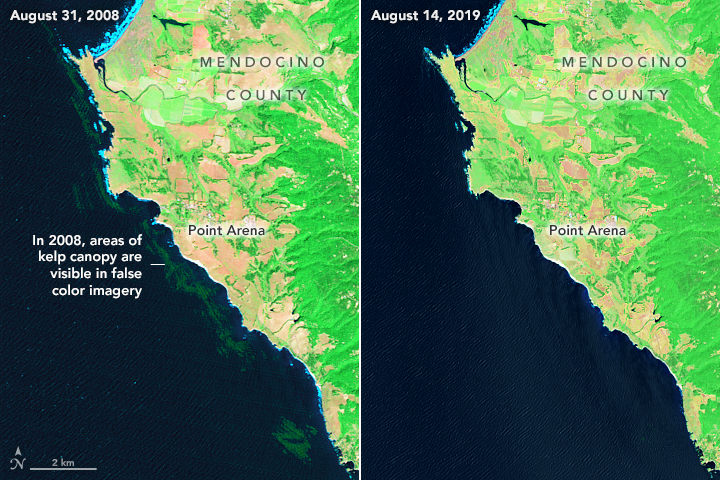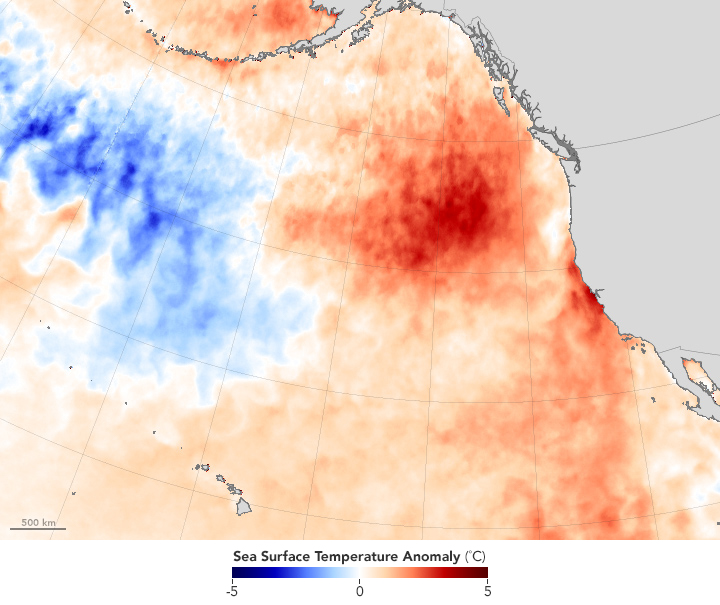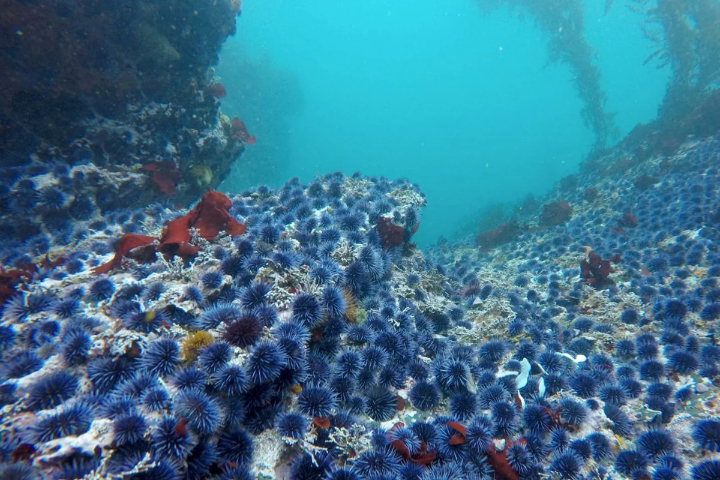

Off the coast of Sonoma and Mendocino counties, changing climate and a marine epidemic have combined to decimate one of California’s most productive ecosystems. In the span of a single year, the region’s renowned kelp forests almost completely collapsed, and they are still struggling. Floating forests that once harbored and fed many marine species have turned into barrens devoid of biodiversity.
Using 34 years of Landsat imagery, a team of researchers led by Meredith McPherson of the University of California, Santa Cruz, documented the fast and catastrophic collapse of the once hardy kelp forest, as well as its struggle to regenerate. The research team found that the Northern California kelp canopy declined more than 95 percent in 2014-15, and the effects persisted for five years.
The map above, based on data from McPherson and colleagues, shows the location of bull kelp forests in 2008 and 2019. The images below show the same areas as observed in shortwave infrared, near-infrared, and red light by Landsat 5 (bands 7,5,3) in 2008 and Landsat 8 (bands 7,5,4) in 2019. The combination helps make some kelp forests visible from space.
Bull kelp is a canopy-forming macroalgae that flourishes in nutrient-rich, cool water and grows as much as 60 centimeters (nearly 2 feet) per day. The kelp is considered an “ecosystem engineer”—the foundational species of a nearshore ecosystem that feeds and shelters other marine life. It is the dominant kelp species north of Monterey Bay, California, with underwater forests thriving along 160 kilometers (100 miles) of rocky reefs from Fort Bragg to Jenner.

Unlike the giant kelp more common to the south, bull kelp is an annual species that grows vigorously from June through August. It then disperses its spores before fall and winter storms dislodge the mature plants from their rocky perches. While the exact location and extent of the bull kelp can change from year to year (based on spore dispersal and environmental factors), the underwater forest has historically regenerated regularly.
Looking across several decades of Landsat observations, McPherson and colleagues found that the geographic distribution of bull kelp contracted, first receding in 2008 in the sandier regions north of Fort Bragg, and then in 2012 in sandier sections south of Jenner. (These areas are just north and south of the map area shown.) But along the rocky substrate in the middle, the bull kelp held strong.
Then came “the blob.” In 2013, a marine heatwave started warming the Bering Sea, and by 2014 the warm waters reached the California coast. Water temperatures rose as much as 2.5°C (4°F) above normal off the U.S. and Canadian coast and stayed high for 226 days—the longest marine heatwave ever recorded. (Sea surface temperatures from July 2015 are shown below.) “The blob” eventually merged with warm waters from the “Godzilla El Niño” of 2015–2016.

The nutrient-poor waters associated with marine heatwaves hinder kelp growth, leading to smaller canopies. Historically kelp have been resilient, though, coming back in force once waters have cooled down. But this time, a cascading series of environmental and biological events—exacerbated by climate change—combined to decimate the forests.
The delicate interplay of species that safeguards kelp forest biodiversity was shifted in 2013 when more than 20 sea star species from Alaska to Mexico started wasting away. In particular, sunflower sea stars, the primary predator of kelp-devouring purple sea urchins, were ravaged by a mysterious wasting syndrome. Renowned regenerators known to grow back entire limbs, the sea stars (starfish) looked as if they had melted to goo.
With this pivotal predator functionally extinct, and bull kelp growing poorly due to the warm water, the balance of predators and feeders was thrown off. Purple sea urchins that had previously occupied shallow tidal pools and ate kelp leaf litter were suddenly eating growing kelp stalks, or stipes. Urchins climbed down the stipes all the way to the seafloor, eating until there was nothing left.
By 2015, the kelp forests were mostly gone, replaced by urchin barrens. Divers described the conversion of once-rich kelp forests into spiky purple carpets. With no kelp left to eat, the purple sea urchins now mostly subsist in a starvation state, rousing occasionally to eat any nascent kelp that tries to establish itself. These zombie urchins are effectively killing the chances of kelp recovery.

The loss of bull kelp forests has meant the loss of the ecosystem services they rendered. California’s recreational abalone fishery—the world’s largest, with over 35,000 fishers—was closed in 2018 after more than 80 percent of these edible sea snails died for lack of kelp sustenance. Kelp harvesting and recreational diving have been clobbered, too. The ecosystem also lost capacity to sequester carbon—kelp are 20 times more efficient than their terrestrial counterparts—and to temper the destructive power of waves.
Restoring the kelp forests is a priority for marine managers, but it is a massive challenge. The purple urchins are of little nutritional interest to most predators or fishermen in their diminished state, yet they have still been observed spawning. A group of citizen scientists known as Reef Check has taken to diving to remove the urchins manually in an effort to create small urchin-free oases where new kelp can grow. In 2020, they scooped, hauled, and composted 20,000 pounds of urchins. Some innovative conservationists also have been removing emaciated urchins to onshore tanks to fatten them up for humans to eat.
The dire kelp situation is an expression of catastrophic tipping points and ecosystem shifts that climate change can bring. The collapse of Northern California’s kelp forests was quick and nearly total. Meanwhile, marine heatwaves are increasing in intensity and frequency, making the long-term recovery of kelp forests uncertain.
Yet there are some hopeful signs. Closer to Alaska, sunflower sea stars are starting to recover. Near Monterey Bay, urchin-eating sea otters have been able to protect local kelp forests. And in spring 2021, Reef Check reported new bull kelp growing at one of the surviving patches off the Mendocino coast.
Freely available satellite data can provide insights about the environmental drivers influencing kelp productivity, potentially helping managers time their restoration efforts for years when conditions will best support kelp growth, McPherson explained. “Landsat has allowed managers to observe regional trends in kelp canopy area and biomass across more than 30 years,” she said. “This is very valuable.”
NASA Earth Observatory images by Lauren Dauphin, using Landsat data from the U.S. Geological Survey and topographic data from the USGS 3D Elevation Program (3DEP). Historical sea surface temperature image by Jesse Allen, using microwave and infrared multi-sensor SST data from Remote Sensing Systems. Photo by Steve Lonhart, NOAA Monterey Bay National Marine Sanctuary. Story by Laura Rocchio, Landsat Communication and Public Engagement Team, with Mike Carlowicz.